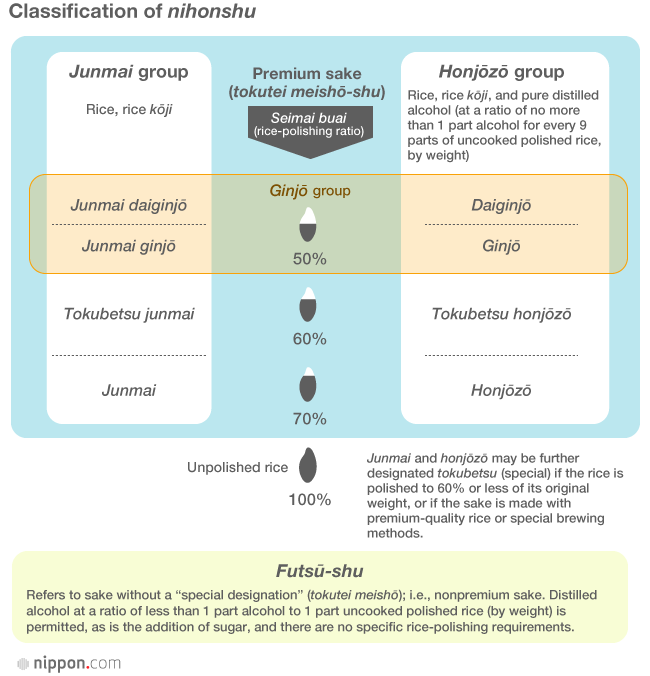
Know Your "Nihonshu": Types of Sake and Their Characteristics
Guideto Japan
Culture- English
- 日本語
- 简体字
- 繁體字
- Français
- Español
- العربية
- Русский
Before buying sake, be sure to check the grade. Sake is graded as either premium or nonpremium—in Japanese, tokutei meishō-shu (literally, “special designation sake”) or futsū-shu (“ordinary sake”). As a rule, your best bet is to stick with premium sake for drinking purposes. The three basic premium designations are junmai, ginjō, and honjōzō, explained below. If none of those designations appears on the label, it is probably not premium nihonshu.
The official classification of premium sake is based on three criteria.
- Ingredients: Sake made only from rice, rice kōji (mold culture), and water is designated junmai-shu (“pure rice sake”). Premium sake that also contains a small amount of pure distilled alcohol is called honjōzō.
- Brewing process: Sake brewed at low temperatures over a long period of time using highly polished rice is called ginjō-shu. (If no distilled alcohol is added to the three basic ingredients, it is called junmai ginjō).
- Seimai buai (rice-polishing ratio): This is a criterion for designation as ginjō and its subtype, daiginjō (super-premium ginjō). It is also one criterion for designation of tokubetsu junmai and tokubetsu honjōzō. Seimai buai is expressed as a percentage, indicating the fraction of the rice kernel that remains after polishing, by weight. A lower percentage signifies more highly polished rice.
Sake made with more highly polished rice—that is, with a lower seimai buai—is generally more expensive, and is usually considered to be more refined in flavor. Thus, daiginjō (super-premium ginjō) is the most expensive class of sake overall. However, while some regard ginjō and daiginjō as the pinnacle of sake making, others prefer the taste of conventional sake.
The addition of distilled alcohol is not a shortcut but a means of adjusting the flavor and aroma. Added in small quantities at a particular stage in the brewing process, the alcohol enhances the fragrance and makes for a lighter flavor. This technique has long been used in the brewing of ginjō as well as honjōzō. However, in recent years, sake drinkers have been gravitating toward the junmai group (including junmai-shu and junmai ginjō-shu), made without distilled alcohol.
 The rice used to make daiginjō (super-premium ginjō) is polished until only a fraction of its original weight remains. Dewasansan (a premium rice strain from Yamagata Prefecture used to make a popular ginjō of the same name) is shown in its unpolished form (left) and after being milled to a seimai buai of 50%
The rice used to make daiginjō (super-premium ginjō) is polished until only a fraction of its original weight remains. Dewasansan (a premium rice strain from Yamagata Prefecture used to make a popular ginjō of the same name) is shown in its unpolished form (left) and after being milled to a seimai buai of 50%
・Nihonshu Now: Behind the Global Sake Renaissance
・Know Your Nihonshu: Understanding Sake Brewing
・Know Your Nihonshu: Sake Tasting Demystified
(Banner photo: A sample of the types and brands of sake available in the premium junmai category. All photographs by Sandō Atsuko. Series banner image by calligrapher Kanazawa Shōko)
